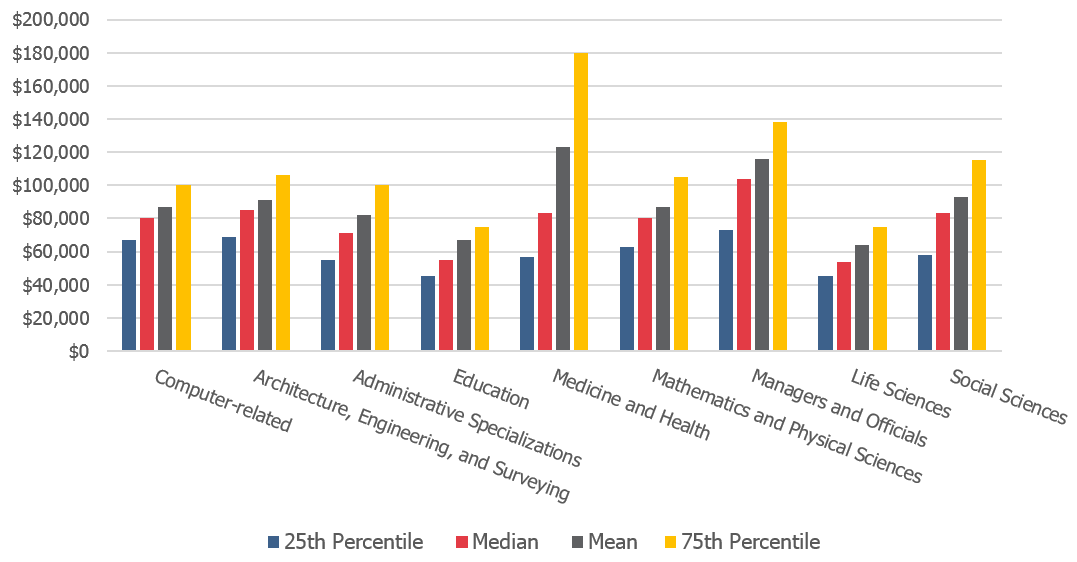H-1B Visas Used for More than Just Tech
What is the H-1B Visa Program?
The H-1B visa program was created in 1990 to allow U.S. employers to file petitions for foreign guest workers with a bachelor’s degree or higher to fill positions in specialized fields. Under current law, 65,000 H-1B workers can be admitted each year. There is an additional allotment of 20,000 visas for foreigners who received an advanced degree from a U.S. higher education institution. The H-1B visa is frequently referred to in the media as a “tech visa”, as in this New York Times piece on how the “Hire American” executive order would affect the program. While a large share of H-1B visas are, in fact, awarded to workers in computer-related occupations, this paints an incomplete portrait of who is using the program. As we at the Bipartisan Policy Center have previously written, the H-1B visa program has been a source of controversy over its impact on American employment and wages. The program is the subject of several pieces of reform legislation introduced this Congress, in addition to President Trump’s “Hire American” executive order.
What Occupations do H-1B Workers Fill?
According to a United States Citizenship and Immigration Services report, approximately two-thirds of the more than 275,000 H-1B workers in the United States were employed in computer-related occupations in fiscal year 2015. Most of these workers were employed either as systems analysts or as computer programmers. This leaves over 90,000 other H-1B workers employed in non-tech industry occupations. The second largest category of H-1B workers (around 8.7 percent) are those employed in architecture, engineering, and surveying. Other leading categories include those with occupations in administration (6.7 percent), education (5.5 percent), and health and medicine (4.2 percent). Calling the H-1B visa purely a “tech” visa is a misnomer, given the variety in employment categories of the program’s beneficiaries. A full listing of the occupations covered under the H-1B visa can be seen in the USCIS report.
Calling the H-1B visa purely a “tech” visa is a misnomer, given the variety in employment categories of the program’s beneficiaries.
What level of education do H-1B workers have?
Because the H-1B program targets high-skill workers, virtually all petitioners have either a bachelor’s, master’s, doctoral, or professional degree. Forty-five percent of H-1B workers have a bachelor’s degree and 44 percent have a master’s degree. Seven percent have a doctorate and 3 percent have a professional degree. A very small number of H-1B workers have less than a bachelor’s, or their education status is unknown, but this constitutes less than two-tenths of a percent of the total number of H-1B workers. The law allows workers to qualify for H-1B if they have experience equivalent to a bachelor’s degree in their field.
How much are H-1B workers paid?
In FY2015, the median compensation of an H-1B worker was $79,000. However, there was much variation across a variety of factors, including geographic location, whether the H-1B worker was new or was continuing their employment, and the worker’s occupational category. The median compensation for a new worker was $70,000, while the median compensation for a continuing worker was $87,000.1 The chart below displays compensation for the nine most numerous occupational categories (Figure 1). It’s clear that there is much variation in compensation across occupational categories of H-1B workers, such as in the case of those working in education versus those working as managers and officials. Additionally, there are different levels of within-category variation. For example, within-variation is relatively low among computer-related occupations when compared to the within-variation in medicine and health occupations.
Figure 1. H-1B Worker Compensation by Occupational Category for FY2015
Source: U.S. Citizenship and Immigration Services, Characteristics of Specialty Occupation Workers (H-1B): Fiscal Year 2015, March 17, 2016.
What countries do H-1B workers come from?
Although H-1B workers come from more than 20 countries, the bulk of these workers, about 70 percent, come from India (Table 1). China represents the second largest share of H-1B workers, generating nearly 10 percent of petitioners. The remaining 20 percent of H-1B workers come from all over the globe. Asia (including the Middle East), Europe, North America, and South America are all represented with a fairly even distribution of visas among them.
Table 1. H-1B Petitioners by Country for FY2015
Source: U.S. Citizenship and Immigration Services, Characteristics of Specialty Occupation Workers (H-1B): Fiscal Year 2015, March 17, 2016.
Conclusion
The H-1B visa has been a key factor in ensuring U.S. firms have the workers they need to remain competitive in a global economy when the domestic labor supply may not be able to fulfill needs. The majority of H-1B visas each year are granted to large IT service firms like Tata, Infosys, Wipro, and Cognizant. However, firms from a wide variety of industries utilize H-1B workers. In addition to tech giants like Google and Facebook, users of the program include Caterpillar, Walmart, JP Morgan Chase, and the Mayo Clinic. Although a large share of H-1B workers do have tech-sector occupations, the H-1B serves a much broader base of U.S. employers beyond the tech sector, and it would be unfair to categorize the visa as a tech visa. The diverse nature of the H-1B program is frequently ignored in reporting and debate on the program. Taking into account the occupational sector, wage, and country of origin considerations of the H-1B program is necessary for producing evidence-based reporting and evidence-based policy.
1 “Continuing worker” refers to workers that have been in the United States for at least one year. H-1B workers can remain in the United States for up to six years.
Share
Read Next
Support Research Like This
With your support, BPC can continue to fund important research like this by combining the best ideas from both parties to promote health, security, and opportunity for all Americans.
Give NowRelated Articles
Join Our Mailing List
BPC drives principled and politically viable policy solutions through the power of rigorous analysis, painstaking negotiation, and aggressive advocacy.

